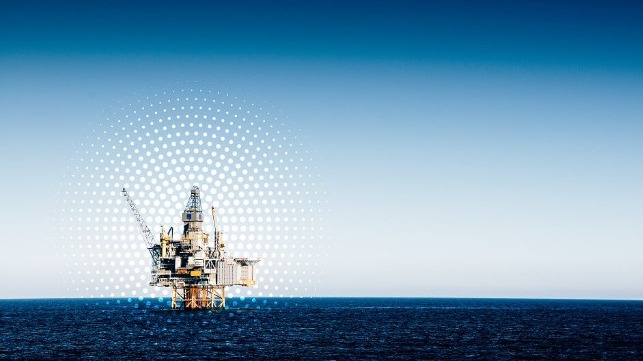Powering the Connectivity Needs of Today’s Digital Offshore Oil Rigs

Surges in oil prices and energy demand has led to dramatically increased investments in offshore drilling. Building ocean-based oil rigs - or “floating cities” – is an expensive proposition as each requires accommodations for employee housing, gyms, and cafeterias, and must have the infrastructure needed to securely transport oil to shore. Once drill sites are up and running, they can deliver profits with fewer emissions per barrel.
Reliable, always-available connectivity is critical for any offshore rig operation. With connectivity, operators can automate production, communicate from rig to shore, improve the health and safety of employees, and monitor for leaks or spills using an array of connected sensors and devices. Industry leaders cite rig-to-shore logistics orchestration and remote production monitoring as the most important aspects of successful offshore operations.[1]
These, and many other industry-specific applications, require the presence of ubiquitous and robust connectivity. With sites getting further and further offshore, where traditional cellular networks often do not reach, satellite communications solutions are the best and, in some cases, the only option.
Improving Operations and Efficiencies Through Remote Monitoring and Automation
Offshore rigs have a wide array of sensors for monitoring assets and collecting various forms of data including temperature, flow, fluid level, fuel consumption, and pressure. With drilling operations continuing to move further from shore, real-time monitoring has become more critical for optimizing productivity, enhancing safety, and quickly flagging any issues that might arise. Satellite connectivity enables the transmission of key data from drilling and production sensors in real time, enabling operators to monitor for any changes in machinery, prevent costly breakdowns, and address safety issues early.
Optimizing Rig-to-Shore Logistics, Orchestration, and Communications
Offshore drilling operations require ongoing communications between all stakeholders, including offshore installation managers (OIM), the supply vessel captain, and third-party vendors. Each plays a unique and critical role in ensuring maximum rig functionality. Satellite connectivity allows all drilling and monitoring data to be shared in real time with onshore employees for instant analysis, asset tracking, and geo-mechanical surveillance. Reliable connectivity makes critical ship-to-shore communications possible, connecting onshore technicians and engineers with offshore crews and allowing for remote troubleshooting and diagnostics. Satellite also supports the integration of corporate IT systems at offshore sites, giving rig crews access to the business communication systems with which they are familiar as well as tools for video conferencing, remote learning tools, and crew training.
Maximizing Onboard Crew Welfare, Safety, and Health
Offshore rigs have anywhere from 50 to over 200 crewmembers at any given time. Managers, engineers, cooks, cleaners, and general crew can spend weeks or months onboard the rig in isolated settings, away from families and friends. Reliable satellite connectivity gives crewmembers a lifeline to their onshore loved ones as well as access to telehealth services and entertainment to keep spirits buoyed. Captains can use satellite-powered applications to track crew activities and ensure enhanced safety compliance through remote crew training. For oil rigs situated in areas prone to rough seas, satellite ensures the delivery of critical real-time weather data to ensure awareness of threats and inform preventative action.
Meeting the Higher Bandwidth Needs of Data-Producing Oil Rigs
Of the 6,713 serviceable offshore vessels in operation today, just 50 percent have broadband connectivity while only 610 rigs are equipped with satellite connectivity of any kind, according to Harbor Research. Disconnected or even poorly connected oil rigs risk the safety of their crews and can lead to inefficient operations and even disastrous oil spills. And with oil rigs expected to increase data output from 21 Mbps per month in 2020 to 200 Mbps by 2030, the requirement for higher bandwidth connectivity solutions available in even the most remote locations is growing even more pronounced.
Digitizing and Connecting Today’s Modern Oil Rig with Intelsat FlexMaritime
Intelsat FlexMaritime is a global, secure, fully managed connectivity solution designed specifically with the need of the offshore drilling industry in mind. Powered by the world’s largest geosynchronous satellite network, FlexMaritime removes the complexity of dealing with bandwidth availability, configuration, and management of network infrastructure, giving oil rig managers and other stakeholders a seamless, reliable, and secure connectivity experience at all times.
FlexMaritime offers multiple layers of throughput where needed, even at the most remote offshore drilling locations. Users of Intelsat’s award-winning, high-performance service never have to worry about a lack of service availability or quality, as FlexMaritime offers consistent, “always on” connectivity anywhere in the world with unrivaled network uptime.
Available exclusively through Intelsat's network of highly experienced Solutions Partners, FlexMaritime can be integrated with innovative value-added services, backed by world-class support, to create the perfect solution for any offshore customer. And with a portfolio of cost-effective, easy-to-install terminals, FlexMaritime is the preferred solution for oil rig operators, offshore managers, and supply vessel captains alike.

that matters most
Get the latest maritime news delivered to your inbox daily.
This article is sponsored by Intelsat. Learn more at http://www.intelsat.com/maritime.
[1] Intelsat 2022 Voice of Customer Survey
The opinions expressed herein are the author's and not necessarily those of The Maritime Executive.
